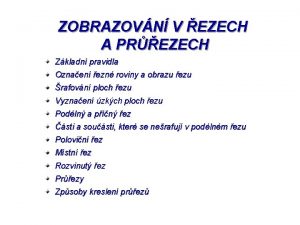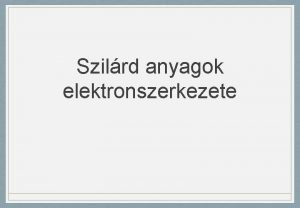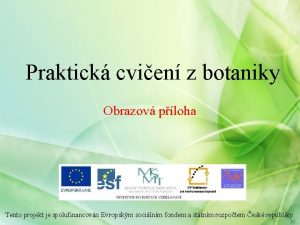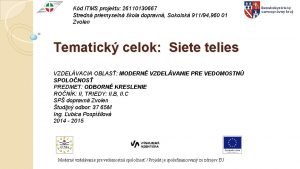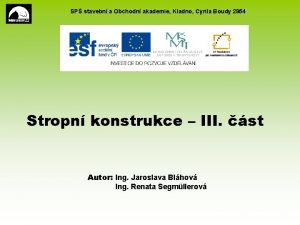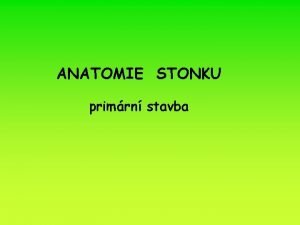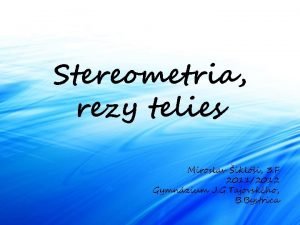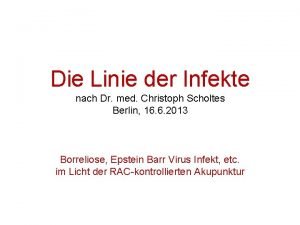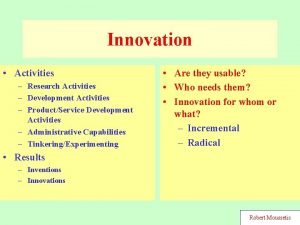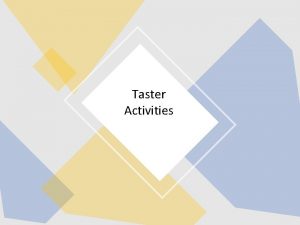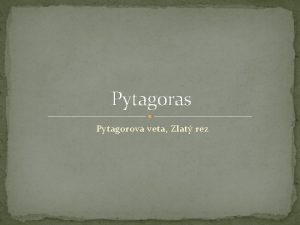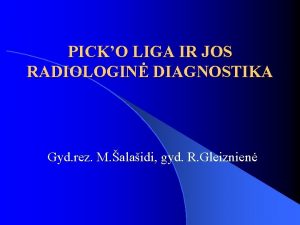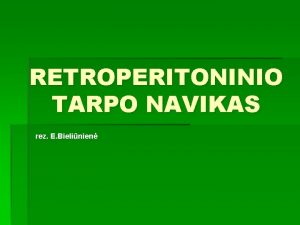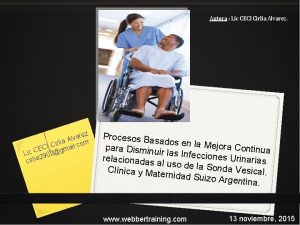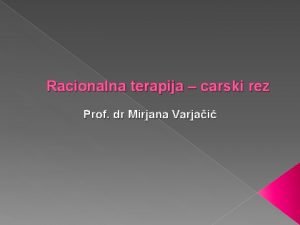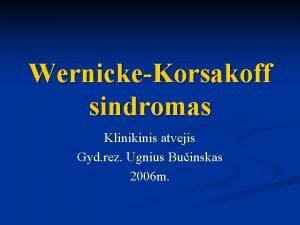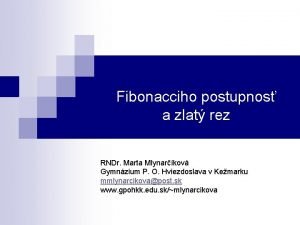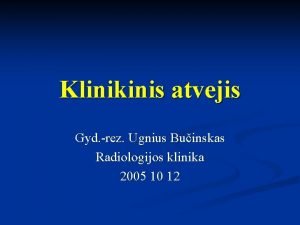UJV Rez a s Activities of UJV Rez




















- Slides: 20

UJV Rez, a. s. Activities of UJV Rez Related to Human Factors and Safety Culture Jan Kubicek Kyiv, 9 th April – 10 th April, 2019 IX International Applied Scientific Conference on NPP Safety Culture

Outline General introduction Power sources in the Czech Republic Czech NPPs: Temelin and Dukovany Introduction of UJV Rez International cooperation WGHOF, WGRISK, EPRI, ESREL, ICDE (CCF) National projects Simulator data collection Methodology for human and organisational factors assessment Regular assessment of operational events for Czech regulatory body using PSA models (precursors) 1

Czech Power Plants 2

Distribution of power sources Gross power generation: 82 TWh (2017) Coal power plants: 37, 6 TWh (45, 8%) Nuclear power plants: 28, 0 TWh (34, 2%) Gas power plants: 5, 1 TWh (6, 3%) Hydro power plants: 2, 9 TWh (3, 5%) Solar power plants: 2, 2 TWh (2, 6%) Biomass: 2, 0 TWh (2, 5%) Wind power plants: 0, 6 TWh (0, 7%) Other (renewable energy): 3, 6 TWh (4, 4%) Total installed electrical capacity: 21 GWe (2014) Thermal power plants: 10, 9 GW (52%) Nuclear power plants: 4, 3 GW (20, 5%) Hydro power plants: 2, 3 GW (11%) Solar power plants: 2, 1 GW (10%) Gas power plants: 1, 3 GW (6%) Wind power plants: 0, 3 GW (1%) 3 Information source: http: //oenergetice. cz/energostat/

Czech Nuclear Power Plants Dukovany NPP (EDU) In operation since 1985(-1987) Four VVER-440/213 pressurized water reactors 2 turbogenerators per reactor - Skoda: 250 MWe each Installed capacity increased up to 4 x 500 MWe during modernisation process in 2005 -2012 Plan for further 5% capacity increase in 2019 -2022 Temelin NPP (ETE) In commercial operation since 2004 Two VVER 1000/320 pressurized water reactors Pressurized water reactor with 4 loops 1 turbogenerator per reactor - Škoda: 1055 MWe 4

UJV Rez – General Information UJV Rez (= Nuclear Research Institute) established in 1955 UJV is a leading subject in research and development activities in nuclear technologies in the Czech Rep. UJV (or daugter comp. Research Centre Řež) operates: 2 research nuclear reactors, hot cell facility, research laboratories, radionuclide irradiators, technology for radioactive waste management, etc. Research activities are mainly targeted at assisting the power plant operator, regulatory body and nuclear facilities contractors Number of employees: >1000 (incl. daughter comp. ) Nuclear Safety and Reliability Division ensures support of safe, reliable and effective operation of NPPs with the focus put on nuclear safety 5

International Cooperation OECD/NEA/CSNI – WGHOF: Working Group on Human and Organisational Factors WGHOF Areas of Interest: Human Factors Engineering and New Technologies Safety Culture, Leadership and Managing for Safety HOF in Human Reliability analysis HOF in Operational Experience Human Performance Improvements programs Organisational Capability UJV is an active member of WGHOF UJV participated at JANSI conference focused on safety culture taken place in Tokio in March 2019 6

International Cooperation - WGHOF Work in progress Organisational Capabilities for Decommissioning Human and Organisational Performance HOF Lessons Learned from Implementation of Post-Fukushima Actions Recently Completed Activities Human Performance and Intervention under Extreme Conditions An Analytical Review of Approaches to Maintaining Oversight of Leadership, Managing for Safety and Safety Culture Licensee Safety Culture 7

International Cooperation – WGRISK Working Group on Risk Assessment Task - HRA in External Events Develop HRA/PSA insights from nuclear operational experience after external events, with emphasis on human performance Identify the special conditions and the nature of modelled human actions relevant for each hazard Disseminate good practices for the qualitative analysis, modelling, and quantification of operator actions in external events PSA Identify method gaps and needed work to address these 8

Simulator Data Collection - Motivation Basic goals: Provide plant with feedback regarding factors influencing operators‘ work, particularly concerning Symptom based procedures (+revision from HF point of view) Available time windows Task complexity Stress level, etc. Improve control room staff training Obtain information for better quantification of human failure events of PSA model Extended goals: 9 improve simulation runs, searching for problems occurred during simulations

Simulator Data Collection Facility: Dukovany & Temelin NPP full-scope training simulators Mode of collection – combination of offline (automatic software) and online (personal observation) collection Cooperation with Czech universities Results and recommendations summarized in EPRI Report: Use of Simulator Data to Support HRA: A Case Study from UJV Rez. EPRI, Palo Alto, CA: 2013. 3002001038. 10

Simulator Data Collection Data collection performed in 3 time periods: First collection: 1998 -2000 18 crews from NPP Dukovany went through 18 different scenarios (each crew passed 6 different scenarios) -> 108 simulator runs Second collection: 2009 -2013 24 -34 crews involved in 11 scenarios -> 330 simulator runs Third collection: 2017 -2020 (ongoing) 32 crews (EDU) + 16 crews (ETE) involved 11

Simulator Data Collection – Conclusions Significant increasing reliability of NPP Dukovany control room crews when working with new symptom based procedures was confirmed (by using of “objective” formal statistical methods) Significant difference between crews performance during re-qualification and after it confirmed on high confidence level -> conclusion: the crews are well trained, the training process was effective HEP adjustment approximately in order of 20 -30% Positive adjustment made in most cases (cooling down by predefined trend) Highest positive adjustment - fast loop isolation after SGTR - HEP value went down by 32. 5% 12

Simulator Data Collection – Conclusions Many specific recomendations related to training, procedures and HRA quantification formulated Communication was found to be key factor when working with symptom based procedures Another key factor is psychological profile of shift supervisor Quality of the process of selection of candidates for operators and particularly shift supervisor function is very important The main findings of the project were presented to CR crews during special education lessons 13

Review of Human and Organisational Factors Methodology developed for Czech regulatory body Main objective: to evaluate level of human and organisational factors (for licensing purposes) Two versions of criteria developed: Currently operated NPPs (with particular focus on operational life extension and management of change) New NPPs Methodology reflects the current state-of-the-art and international good practice (IAEA, NRC, …) Supporting software HUFAL developed 14

Review of Human and Organisational Factors 10 factors defined - each reflected by 8 -9 specific criteria - in total 80 (new NPPs), resp. 88 (operating NPPs) criteria defined Safety factors considered in the methodology 1. Operating experience review 2. Functional requirements analysis, function allocation and task analysis 3. Adequate competence requirements for operating, maintenance, technical and managerial staff 4. Qualified staff available on duty at all times 5. Staff selection methods are systematic and validated 15

Review of Human and Organisational Factors Safety Factors Considered in the Methodology (cont. ) 6. Adequate programmes for initial training, refresher training and upgrading training (including the use of simulators) 7. Human factors verification and validation (PSA, deterministic safety analysis) 8. Human–machine interface design (control room and other workstations) 9. Procedure development 10. Design implementation and human performance monitoring 16

Review of Human and Organisational Factors Special supporting software (HUFAL) developed 17

Review of Human and Organisational Factors References used: IAEA Safety Standards No. SSG-25: Periodic Safety Review for Nuclear Power Plants Specific Safety Guide, IAEA, Vienna, 2013 US NRC, Combined License applications for Nuclear Power Plants (LWR Edition), Regulatory Guide 1. 206: Chapter C. I. 18 Human Factors Engineering, NRC, Washington, June 2007 18

Thank you for your attention! 19
 Both indoor and outdoor sports
Both indoor and outdoor sports Support activities and primary activities
Support activities and primary activities Examples of primary activities
Examples of primary activities The statement of cash flows helps users
The statement of cash flows helps users Autoportert
Autoportert Ag vegyjel
Ag vegyjel Lomený řez
Lomený řez Svislý řez půdou
Svislý řez půdou Lisa dora sonet
Lisa dora sonet Réz elektronszerkezete
Réz elektronszerkezete Příčný řez stonkem dvouděložné rostliny
Příčný řez stonkem dvouděložné rostliny Rez kocky rovinou
Rez kocky rovinou Leonardo da vinci matematika
Leonardo da vinci matematika Sklopený řez
Sklopený řez Uo housing starrez
Uo housing starrez Příčný řez listem
Příčný řez listem Eustélé
Eustélé Trikotna kompozicija
Trikotna kompozicija Stereometria vzorce
Stereometria vzorce Rez. cystitiden
Rez. cystitiden Stroboskop fizik
Stroboskop fizik






